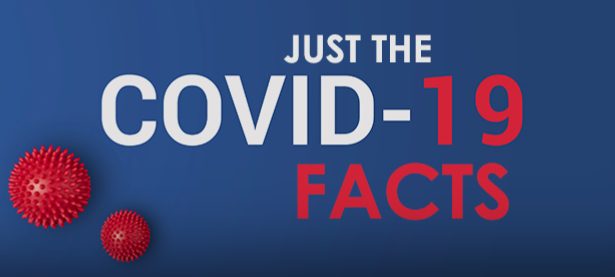
EBAW SPECIAL REPORT
Reviewed by Zorba Paster, M.D.
The COVID-19 pandemic is on everyone’s minds, and it’s natural to go online for information. Unfortunately, with the enormous number of websites, navigating what’s accurate, unreliable or downright bogus isn’t always easy. That's why we created this post and other materials about this virus. Utilizing evidence-based information is extremely important right now as it could mean the difference between life and death.
Note: Due to the quickly changing nature of the COVID-19 pandemic, check for daily updates at the CDC: www.coronavirus.gov.
Q: What is coronavirus 19 (COVID-19)?
A: COVID-19 is a highly infectious disease caused by a new, or novel, coronavirus. It is not a flu virus. Coronaviruses include those that cause colds, SARS and MERS. It is spread mainly person to person within about 6 feet of each other. Droplets released by coughing and sneezing are inhaled through the mouth and nose, and potentially the lungs.
Q: Why is COVID-19 so infectious?
A: People may not show symptoms until several days after they become infected. In that time, they can spread the virus to many people. The CDC recommends that people stay at least 6 feet away from each other (called social distance) to reduce the risk of infection.
Q: What are the symptoms?
A: Symptoms are cough, fever and shortness of breath. If you have these symptoms, and you’ve had contact with a person who has COVID-19 or you live in or have recently visited an area with COVID-19, contact your health care provider immediately. The CDC says symptoms may appear 2 to 14 days after exposure.
Q: Is handwashing better than hand sanitizer?
A: Yes. Frequent handwashing is the most important action you can take to protect yourself and others from infection. Use alcohol-based hand sanitizer with at least 60% alcohol if soap and water aren’t available. Cover your entire hands with the sanitizer and rub them together until they are dry.
Q: What’s the right way to wash hands?
A: Use soap and water for at least 20 seconds. Rub your hands so you create a lather that covers your entire hands. Do this especially after you cough or sneeze, before food preparation and eating, and after using the bathroom. Always wash your hands after touching common objects and surfaces in common and public areas, including door handles, elevator buttons and stair railings.
Q: What other measures reduce the risk of infection and spread of COVID-19?
A: Avoid touching your mouth, nose and eyes (called the T Zone) with unwashed hands. If you don’t have a tissue handy, cough or sneeze into the crook of your elbow. Avoid shaking hands. Put used tissues in lined trash cans.
At home and in your work area, disinfect frequently touched objects and surfaces, such as laptops, phones, tablets and countertops. Anything touched frequently by multiple people is considered high-contact.
If you’re sick, stay home, except when you need medical care. Avoid public areas and transportation. Wear a face mask around other people and pets at home, outdoors and in health care facilities. Note: The CDC doesn’t recommend masks for uninfected people. Your health care provider will tell you how long you should self-quarantine.
Q: Who is at highest risk?
A: The elderly and those with chronic conditions, such as heart disease, lung disease and diabetes, are at higher risk for severe symptoms and complications, including pneumonia. While the risk of serious illness is believed to be low for most people, it’s crucial for everyone to take precautions, such as social distance and frequent handwashing.
Q: How are children affected by COVID-19?
A: As of this writing, the impact on children’s health is unknown. However, children need the precautions listed above, especially if they have asthma or other chronic conditions.
Q: The World Health Organization has declared COVID-19 a pandemic. What does that mean?
A: Pandemic, like the term epidemic, simply means that the disease has spread around the world. It doesn’t mean that the severity or symptoms have changed.
COVID-19: Health Websites We Recommend
To find trustworthy health websites, look for .org, .edu, and .gov website addresses., including:
Harvard, Yale, Mayo, UCLA and many other well-known medical centers, universities, government agencies and non-profit organizations are also good sources.
For a PDF version of this information, click here.
Sources:
“People at Risk for Serious Illness from COVID-19.” CDC, 3/8/20.
Accessed 3/13/20 at https://www.cdc.gov/coronavirus/2019-ncov/specific-groups/high-risk-complications.html.
“How COVID-19 Spreads.” CDC, 3/4/20.
Accessed 3/13/20 at https://www.cdc.gov/coronavirus/2019-ncov/about/transmission.html.
“When and How to Wash Your Hands.” CDC.
Accessed 3/13/20 at https://www.cdc.gov/handwashing/when-how-handwashing.html.
“WHO Director-General’s opening remarks at the media briefing on COVID-19 - 11 March 2020”. WHO, 3/11/20.
Accessed 3/13/20 at https://www.who.int/dg/speeches/detail/who-director-general-s-opening-remarks-at-the-media-briefing-on-covid-19---11-march-2020.
“Watch for Symptoms.” CDC, 3/14/20.
Accessed 3/16/20 at https://www.cdc.gov/coronavirus/2019-ncov/symptoms-testing/symptoms.html.
The original version of this page was published at: https://blog.ebix.com/covid-19
A.D.A.M., a business unit of Ebix, is the most credible and innovative source of health care information and multimedia visual learning assets for hospitals, health care organizations, educational ... Read more
What should you do if you think you've contracted COVID-19?The answer may not be what you think. In fact, there are many websites that give inaccurate or unreliable advice during ...read more
Every week there’s a new digital scare. Target was hacked. Home Depot was hacked. LinkedIn was hacked. Cheating site Ashley Madison was hacked (which didn’t seem to garner ...read more
When Google promoted a software engineer named Chade-Meng Tan to the role of “Jolly Good Fellow”, his career – and the entire culture of Silicon Valley – took ...read more